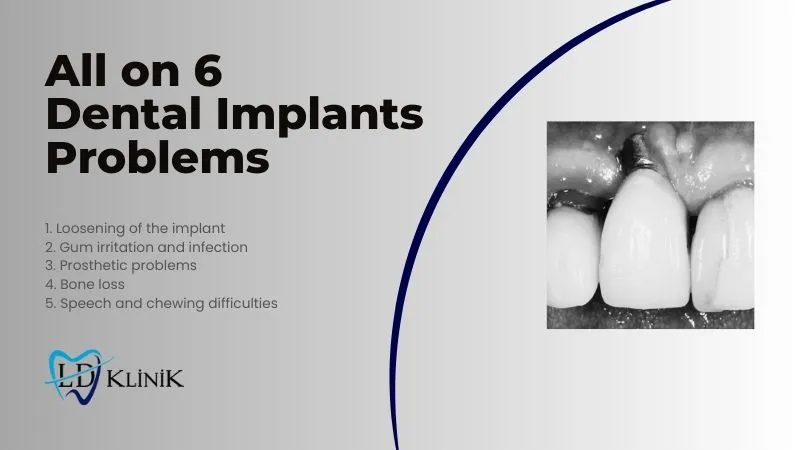A Comprehensive Solution for Tooth Replacement
All-on-6 implants must fuse to the bone after insertion into the jawbone. This fusion allows the implant to function safely for many years. However, in some cases, the implant fails to properly osseointegrate with the jawbone, which can lead to loosening. This risk is particularly high in people who smoke, drink alcohol, are older or have health problems such as diabetes. The volume of the jawbone is also an important determinant of success.

This is usually recognised by a slight movement of the teeth or discomfort during chewing. In such a case, if the implant is checked in time, most cases are resolved by early intervention. Sometimes, however, the implant needs to be re-fixed or replaced if necessary.
According to the results of a 6-year study, implant failure was recorded in 12 out of 376 implants fixed, this 6-year follow-up shows an overall failure rate of 3.11%.At the same time, late failure was more common than early failure. Early failure was due to lack of osseointegration, while late failures were due to peri-implantitis.
The gums around All-on-6 implants become inflamed due to insufficient cleaning and this is called ‘peri-implantitis’. If left untreated, this condition damages the bone around the implant and shortens the life of the implant.
Symptoms of peri-implantitis are initially mild; it starts with redness and slight swelling of the gums, bleeding when brushing teeth or a bad taste or odour in the mouth. When these symptoms are noticed, consulting a dentist immediately will prolong the life of the implant.
Peri-implantitis is treated with professional dental care and regular dental check-ups. Proper brushing of the teeth, use of dental floss, antiseptic mouthwashes and regular dentist examinations both prevent infection and help the implant to last longer. In a study, the incidence of peri-implantitis was determined as 12.53% on implant basis.
All-on-6 dental implants have fixed teeth on them. These are made of durable materials; however, some problems can develop over time. For example, the prosthesis may crack or break due to hard foods or trauma. In addition, the screws that attach the prosthesis to the implants loosen over time. In terms of aesthetics, discolouration or abrasion due to pressure can occur. Such problems are solved by repairing or renewing the prosthesis.
The experience of the dentist plays an important role in the treatment of All on 6 dental implants. Sometimes dentists position the implants incorrectly, so that the prosthesis does not fit well and patients feel discomfort during functions such as chewing and speaking. In addition, a prosthesis that is not fully and well placed causes pain and discomfort.
All-on-6 implants help maintain jawbone health and prevent bone resorption. However, in some cases, the bone around the implant is lost. The reasons for this are teeth grinding or gum diseases.
To prevent bone loss, paying attention to oral hygiene, using night plaque (if you are clenching the teeth) and not applying excessive pressure on the implants help to maintain bone health.
Due to the newly placed implants and prostheses, there are slight difficulties in speaking and this requires a period of acclimatisation in the mouth. Most patients get used to this process completely within 1-2 weeks. If necessary, the dentist will make minor adjustments.
Some precautions should be taken to ensure that are long-lasting and trouble-free:
All-on-6 implantsIf you take these precautions and with a good research, it is necessary to choose a dentist and dental clinic. This blog post is written for informational purposes only. In case of a complication, please contact your dentist.
If you would like to get All on 6 dental implant Antalya with the professional and experienced team of LD Clinic, we would be pleased to hear from you.